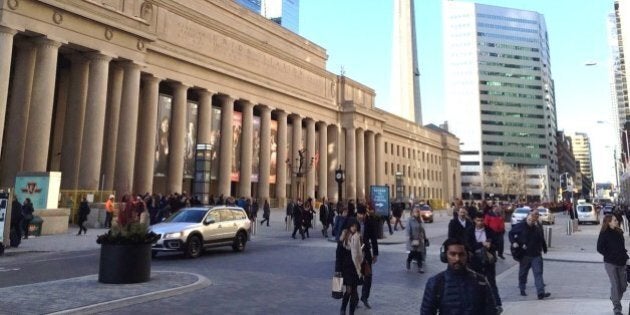
It's the age-old battle between form and function. In the name of beautifying streets and the desire to create urban promenades, we often end up with poorly planned arterials that subject pedestrians and others to unnecessary safety risks.
Look no further than the Front Street at Union Station in Toronto, where every morning a flood of commuters inundates the neighbouring streets, forcing pedestrians and vehicles to share space when they are least willing to yield.
The culprit is an artificially narrowed road segment outside of Union Station. The street has been "beautified" and made "pedestrian friendly." Or so we have been told. With no signage for priority use at the most contested piece of road real estate in Canada, pedestrians and drivers are fighting it out.
Outside Union Station it's the Monday morning blues and then some. Earlier this morning, cars were lined up with frustrated drivers trapped in a single lane in each direction. Pedestrians in hundreds were crossing the Front Street mid-block. A cab driver was relentlessly blaring his horn trying unsuccessfully to prevent a flooding stream of pedestrians from crossing the road. A black Jeep, fortunately at crawling speed, inadvertently touches a young pedestrian. She turns around in anger and kicks the Jeep's side door.
No one seemed to be enjoying the beautified street.
It doesn't have to be this way. When it comes to streets and arterials, form should follow function (and safety).
Union Station is the busiest transportation hub in Canada offering urban, regional and intercity bus and rail services. In addition, it is located in Canada's busiest and largest employment centre. Why then is the road segment opposite Union Station narrowed to a single lane in each direction? This results in queues that stretch back to intersections at Bay Street and University Avenue, an entire city block in either direction.
Transportation Engineering recommends providing safe and efficient access by road to Union Station so that commuters, in addition to arriving by other transit modes, could be driven in cars or cabs to board the multitude of transit services. Such consideration seems not even an afterthought for Union Station where the redesigned road segment seems planned to choke rather than to facilitate traffic.
You might think that if the road is not helping traffic, it must be helping the pedestrians. Not really. During rush hours, the place resembles a war zone between GO Train commuters who cross the street where Front Street narrows down to one lane in each direction.
GO Trains arrive at Union Station often with over 1,600 passengers per train. When several trains arrive at Union within minutes of each other, a steady stream of pedestrians pours onto the neighbouring streets, including Front Street where hundreds cross the street mid-block.
Obvious signs or signals (e.g., crosswalk) to advise who has the right of way are missing, which results in a battle of nerves between drives and pedestrians that often matures into kicking and shouting, as was the case this Monday morning.
It doesn't have to be this way. When it comes to streets and arterials, form should follow function (and safety). The primary function of the Front Street is to link the largest employment centre in Canada with the most active transport hub. It involves crossing the Front Street more so than strolling along it. One can beautify the street after one has engineered the street for its primary use. This seems not to be the case with Front Street.
The drivers and pedestrians would be well-served if one were to consider the following changes. In the interest of pedestrian safety, the city should restrict pedestrians from crossing the Front Street mid-block between Bay Streets and University Avenue. Pedestrians are most vulnerable crossing at mid-block than at signalized intersections.
The intersections at Bay Street and University Avenue should be reconfigured for pedestrian priority for morning and evening rush hours. Given the large pedestrian volumes, the intersection at Bay and Front Streets is a good candidate for a pedestrian scramble, like the one at Yonge and Dundas Streets.
Since the Front Street serves prominent destinations on both north and south sides, it requires vehicular (cab) access for commuters heading to Union Station and those to Royal York Hotel or the neighbouring office towers.
Reducing the street to one lane causes unnecessary blockage when an idle vehicle, boarding or alighting a passenger, occupies the lane. Restoring two lanes in each direction will allow a parking lane for cabs and others, while the traffic can flow in the other lane.
One hopes are that once the work on Union Station is finally finished, Torontonians would have a functioning transit hub that looks pretty and also moves people efficiently and safely.
Follow HuffPost Canada Blogs on Facebook
MORE ON HUFFPOST:
